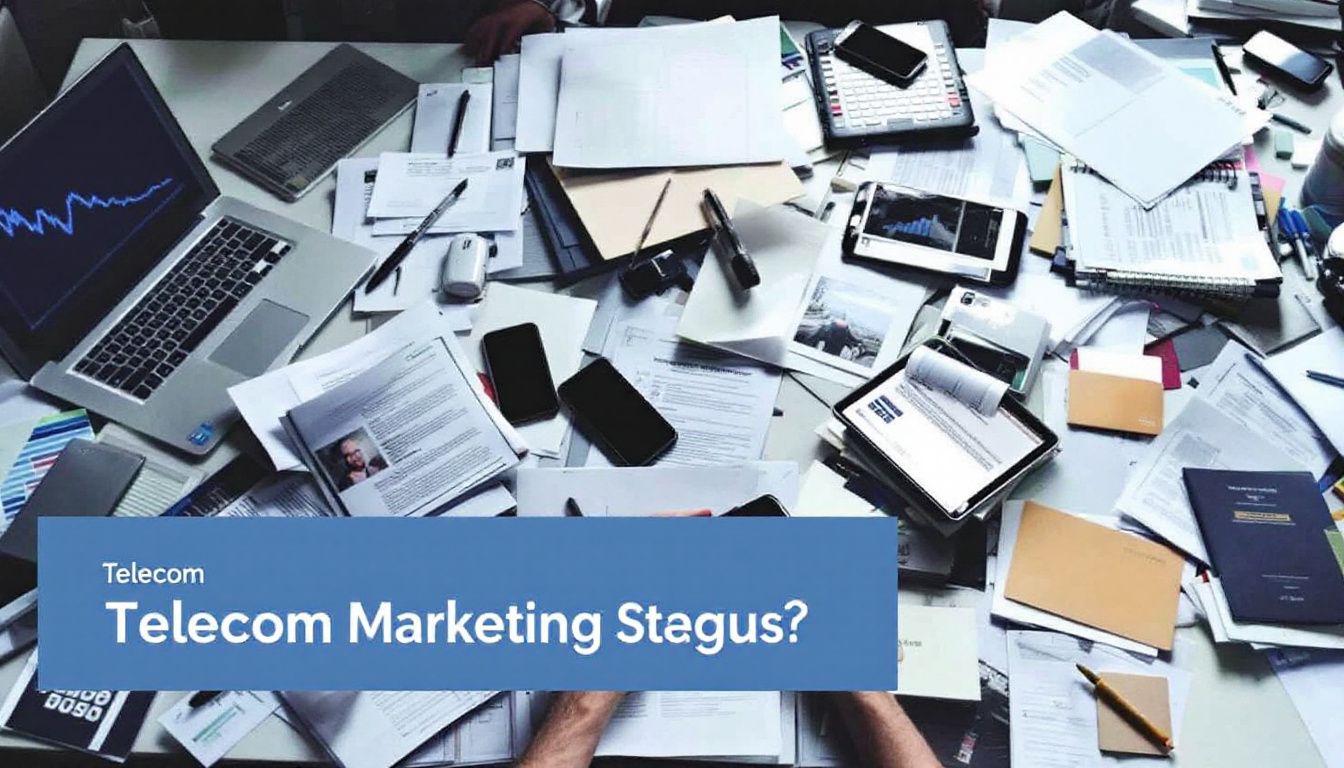Are you tired of losing phone customers each month, even after your best marketing efforts? You’re not alone. Telecom companies across the United States lose about $65 million per month from customer churn. 3 I looked into why this happens and found a way to fix it. With a clear telecom marketing strategy, I’ll help you reduce churn effectively, find the audience you’re looking for, and offer them experiences they’ll truly enjoy. 1 Keep reading—the solution is easier than you might think!
Key Takeaways
- Telecom companies lose around $65 million every month due to customer churn—but a clear, friendly marketing approach can fix that.
- T-Mobile’s “Uncarrier” strategy, with its relaxed vibe and customer-first thinking, pushed them past giants AT&T and Verizon in market value.
- Holding onto current customers costs 50 times less than chasing new ones—Telus, for example, spends only CAD 521 per customer to bring new people on board.
- Adding small personal touches to marketing—like thoughtful messages or personalized deals—can lower churn rates by as much as 30%.
- Bundling services (phone, internet, cable, etc.) makes customers stick around longer—they feel happier and stay loyal to the provider.
Key Components of a Telecom Marketing Strategy

A strong telecom marketing plan starts with a clear map of who you want to reach. I need to know what makes my service stand out from others, plus how to use customer data to make smart choices.
Identifying target customers
Before building my telecom marketing plans, I first need clear insights on who really wants my services. Good audience research pinpoints customers who match what I’m selling. In telecom, this usually means checking age ranges, income, and how people prefer to use technology.
For instance, around 84% of people in North America used mobile phones in 2021—but each group wants different things. Many telecom brands now rely on data analytics, finding patterns in what users choose and buy.
They build clear profiles from that data. 1
Savvy telecom marketers don’t shy away from niche groups, either. That’s why companies roll out sub-brands like VOXI, SMARTY, and Visible—they each aim for certain customer groups.
Mobile Virtual Network Operators (MVNOs) usually serve specialized segments, like younger buyers or recent immigrants. Canada is a good example, since it regularly welcomes many new residents.
Market research tells us different segments have unique priorities… some care mostly about price, others about internet speed or reliable signal coverage. Great marketing matches services directly with customer needs.
Defining a unique selling proposition (USP)
A strong, clear USP helps telecom companies stand out—it’s that simple. It needs to clearly tell customers why they should choose your service over others. T-Mobile nailed this with their casual, customer-friendly “Uncarrier” strategy.
It worked so well that T-Mobile passed big names like AT&T and Verizon in market value. 3
A solid telecom USP usually highlights something special: maybe new tech, lower prices, or great customer service… whatever solves real annoyances that users face. Customers prefer genuine, straightforward benefits—so honesty pays off.
Your marketing should clearly underline these advantages in every ad, social media update, and customer interaction. 2
Leveraging data analytics for insights
I use data analytics to clearly understand my customers. First-party information lets me improve the experience for people using my telecom services. With tools like Fusion Platform, I get a unified view of customer details—making it simpler to offer relevant products, at exactly the best moment.
Data saves me money, too. Telus discovered keeping a customer costs 50 times less than gaining a new one—just CAD 521 per new customer. Smart use of analytics means personalized marketing by customer groups, quick fixes for network problems, and ensuring I bill correctly.
These insights support growth and steadily increase each customer’s value. 4
Effective Telecom Marketing Techniques
I’ve found some cool ways to boost sales in telecom. Smart marketing moves can help you stand out in a crowded phone market.
Bundled services and cross-selling
I bundle internet, TV, and mobile services into one simple package for my customers. Doing this offers them extra value, keeps them happy, and makes them stay longer. My data clearly shows: customers who get multiple services from just one provider stick around. 5 And the best part happens once a customer who only wanted internet adds a mobile plan too. Cross-selling services in bundles is effective, because people enjoy the convenience of just one bill for all telecom needs.
In fact, many loyal customers began with only one service—then later added more from our options.
Loyalty programs and customer incentives
Loyalty programs really shine in telecom marketing—they keep customers hooked with smart incentives and exclusive perks. T-Mobile nails this concept perfectly with its “Tuesdays” deals, and Virgin Media O2 offers special treats through their “Priority” rewards program. 6
From a business viewpoint, keeping a current customer is 5 to 25 times cheaper than finding new ones—that’s a huge saving. My telecom clients especially favor loyalty plans with tiered rewards, which give customers better bonuses over time.
These programs encourage steady engagement, build genuine emotional connections, and turn regular customers into true brand advocates. Soon enough, happy customers become your biggest promoters—spreading good reviews and recommendations to friends and family. 7
Content marketing and storytelling
Beyond basic rewards, I tell stories that customers remember. With content marketing, I share helpful info—and build trust along the way. I produce videos that clearly show how our phone plans help real people solve everyday problems.
And yeah, those videos always get way more clicks than plain old text. 8 My team creates content that speaks to emotions, not just dry facts about data plans or network speeds.
Storytelling is a powerful tool for telecom marketing. My team ties our brand values directly to customer experiences, through short, relatable success stories. These stories build stronger connections than discounts ever could.
High-quality blog posts, videos, and social media content position us as industry pros. 8 And the numbers speak loud and clear—emotional storytelling drives higher sales and longer-lasting customer loyalty than straightforward product ads. 9
Enhancing Customer Experience
I want to make my customers feel special with a personal touch at every step of their journey – from the first ad they see to the help desk call that fixes their problem… read on to see how I create magic moments that keep customers coming back for more.
Personalized marketing strategies
My job is to craft personalized messages—based on what each customer likes. It’s one way we boost our sales, keeping folks loyal to our phone company. 10 My team checks past purchase data, then texts people offers that match their needs.
Way better than sending everyone the same old ad, right? And the numbers back this up—adding personal touches cuts churn rates by up to 30%. 11 Sending the right message, at just the right moment, helps customers feel valued.
Now, let’s explore how we can improve every customer interaction.
Improving customer service touchpoints
It’s not just about personalized deals—every customer interaction matters. Great service keeps customers loyal. So, I make sure phone support is clear, chat is quick, and social media teams step in fast with real solutions.
These points really do count, since 78% of customers say great service keeps them loyal longer.
Billing often frustrates telecom customers. To ease this, I created clear payment systems with easy-to-read statements and simple mobile payments. Handy self-service tools help customers track their usage, pay bills online, and solve common issues on their own.
This cuts down wait times and lifts customer satisfaction. Regular quick surveys catch small issues early on. Fixing these little pain points often leads to happier customers and fewer cancellations down the road. 12
How Does Verizon’s Marketing Strategy Reflect Broader Telecom Marketing Strategies?
Verizon’s marketing strategy exemplifies a blend of technology and customer engagement, mirroring broader telecom trends. By prioritizing personalized experiences and leveraging data analytics, Verizon excels in attracting and retaining customers. For those interested in the sector, understanding verizon’s innovative marketing approach reveals insights that can enhance competitive positioning across the industry.
Conclusion
Telecom marketing today needs a sharp, simple game plan. The market is crowded—customers have tons of choices—so knowing exactly what they want matters. My goal is clear: understand customers and offer real value they actually notice.
Using data smartly helps catch issues early, spot new trends, and keep customers smiling. Great marketing blends digital tech with those small, personal touches that matter to people.
Fancy ads alone don’t build lasting trust—reliable, friendly, easy-to-use service does. Winning in telecom means combining tech know-how with genuine care—that’s how brands thrive and customers stick around.
References
- ^ https://www.haveignition.com/industry-guides/go-to-market-strategy-for-telecommunications
- ^ https://www.zendesk.com/blog/unique-selling-proposition/ (2024-03-11)
- ^ https://www.mojenta.com/blog/how-to-create-a-unique-selling-proposition-for-your-telecom-business (2018-10-17)
- ^ https://medium.com/@kanerika/data-analytics-in-telecom-industry-a-comprehensive-guide-01a152f6977a
- ^ https://www.novatiq.com/telecom-marketing-strategies-turbocharge-marketing-reach-customers/
- ^ https://antavo.com/blog/telecommunication-loyalty-programs/ (2023-12-12)
- ^ https://www.loyaltyxpert.com/blog/telecommunication-loyalty-programs/ (2024-12-26)
- ^ https://www.linkedin.com/pulse/5-successful-telecom-marketing-strategies-haroon-gulzar
- ^ https://www.abstraktmg.com/telecom-digital-marketing/
- ^ https://www.xerago.com/xtelligence/personalized-marketing-strategies (2024-11-20)
- ^ https://www.researchgate.net/publication/377198635_The_Influence_of_Service_Personalization_Customer_Satisfaction_and_Customer_Retention_in_the_Telecommunications_Industry_on_Data-Driven_Marketing
- ^ https://www.wavetec.com/blog/telecom/creating-customer-experience-in-telecoms/







